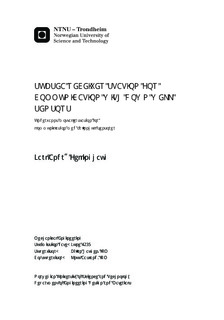SUBSEA RECEIVER STATION FOR COMMUNICATION WITH DOWN WELL SENSORS - Undervanns mottakerstasjon for kommunikasjon med brønnhull sensorer
Master thesis
Permanent lenke
http://hdl.handle.net/11250/2400540Utgivelsesdato
2013Metadata
Vis full innførselSamlinger
Sammendrag
The scope of this project was to develop a purpose designed communication platform for subsea applications. The company Wireless Instrumentation Systems (WINS) AS has a pilot project with Statoil ASA on the production fields Gullfaks and AAsgard. WINS will install retrofit autonomous well-sensors that will transmit data wirelessly from the well to the seabed.
This project outlines the development phase of this communication system providing the ?last mile? of signal transmission from the seabed to the topside platform or production center.
The main concern for this platform is the subsea currents as they might induce vibrations to the frame structure. This will disable the platforms ability to receive signals from the well-sensors as the principle of communication is very weak electromagnetic waves. To receive these signals, hypersensitive magnetometersare used in a 3D array. As a pilot project WINS will also test the reception principle of measuring electric potential on the seabed by the use of electrodes. A deployment system for this must be incorporated in the design.
Several concepts were conceived and discarded as they failed the requirement specifications during analysis. However, this data gained knowledge to design the final concept, with success.
The final concept has a very rigid frame with a tetrahedron shape. All materials are non-magnetic as this would distort the signal reception. An interconnected pressure vessel system contains the magnetometers and the data acquisition unit. Each magnetometer is firmly attached to the rigid frame structure to avoidvibrations. The electrodes will be deployed by the use of purpose built cable spool frames, which will be performed by a Remotely Operated Vehicle (ROV).
This report describes in detail the integrated concepts of the final product and how it addresses the requirement specifications given by WINS and Statoil ASA.
